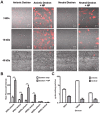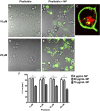Synergistic antitumor activity from two-stage delivery of targeted toxins and endosome-disrupting nanoparticles
- PMID: 23444913
- PMCID: PMC3646422
- DOI: 10.1021/bm3019906
Synergistic antitumor activity from two-stage delivery of targeted toxins and endosome-disrupting nanoparticles
Abstract
Plant-derived Type I toxins are candidate anticancer therapeutics requiring cytosolic delivery into tumor cells. We tested a concept for two-stage delivery, whereby tumor cells precoated with an antibody-targeted gelonin toxin were killed by exposure to endosome-disrupting polymer nanoparticles. Co-internalization of particles and tumor cell-bound gelonin led to cytosolic delivery and >50-fold enhancement of toxin efficacy. This approach allows the extreme potency of gelonin to be focused on tumors with significantly reduced potential for off-target toxicity.
Figures






Similar articles
-
Fusion of gelonin and anti-insulin-like growth factor-1 receptor (IGF-1R) affibody for enhanced brain cancer therapy.Arch Pharm Res. 2017 Sep;40(9):1094-1104. doi: 10.1007/s12272-017-0953-7. Epub 2017 Sep 12. Arch Pharm Res. 2017. PMID: 28900896
-
Preparation and Characterization of Gelonin-Melittin Fusion Biotoxin for Synergistically Enhanced Anti-Tumor Activity.Pharm Res. 2016 Sep;33(9):2218-2228. doi: 10.1007/s11095-016-1959-4. Epub 2016 Jun 1. Pharm Res. 2016. PMID: 27251414 Free PMC article.
-
Combination of antibody targeting and PTD-mediated intracellular toxin delivery for colorectal cancer therapy.J Control Release. 2014 Nov 28;194:197-210. doi: 10.1016/j.jconrel.2014.08.030. Epub 2014 Sep 7. J Control Release. 2014. PMID: 25204286 Free PMC article.
-
15 years of ATTEMPTS: a macromolecular drug delivery system based on the CPP-mediated intracellular drug delivery and antibody targeting.J Control Release. 2015 May 10;205:58-69. doi: 10.1016/j.jconrel.2014.12.002. Epub 2014 Dec 4. J Control Release. 2015. PMID: 25483423 Review.
-
Advanced targeted therapies in cancer: Drug nanocarriers, the future of chemotherapy.Eur J Pharm Biopharm. 2015 Jun;93:52-79. doi: 10.1016/j.ejpb.2015.03.018. Epub 2015 Mar 23. Eur J Pharm Biopharm. 2015. PMID: 25813885 Review.
Cited by
-
Engineered Polymeric Materials for Biological Applications: Overcoming Challenges of the Bio-Nano Interface.Polymers (Basel). 2019 Sep 2;11(9):1441. doi: 10.3390/polym11091441. Polymers (Basel). 2019. PMID: 31480780 Free PMC article. Review.
-
Plant Ribosome-Inactivating Proteins: Progesses, Challenges and Biotechnological Applications (and a Few Digressions).Toxins (Basel). 2017 Oct 12;9(10):314. doi: 10.3390/toxins9100314. Toxins (Basel). 2017. PMID: 29023422 Free PMC article. Review.
-
Cetuximab Immunoliposomes Enhance Delivery of 5-FU to Skin Squamous Carcinoma Cells.Anticancer Agents Med Chem. 2017;17(2):301-308. doi: 10.2174/1871520616666160526110913. Anticancer Agents Med Chem. 2017. PMID: 27225449 Free PMC article.
-
Immunotoxins constructed with ribosome-inactivating proteins and their enhancers: a lethal cocktail with tumor specific efficacy.Curr Pharm Des. 2014;20(42):6584-643. doi: 10.2174/1381612820666140826153913. Curr Pharm Des. 2014. PMID: 25341935 Free PMC article. Review.
-
Two-Step Targeted Drug Delivery via Proteinaceous Barnase-Barstar Interface and Doxorubicin-Loaded Nano-PLGA Outperforms One-Step Strategy for Targeted Delivery to HER2-Overexpressing Cells.Pharmaceutics. 2022 Dec 24;15(1):52. doi: 10.3390/pharmaceutics15010052. Pharmaceutics. 2022. PMID: 36678681 Free PMC article.
References
-
- Atkinson S. F.; Bettinger T.; Seymour L. W.; Behr J. P.; Ward C. M. J. Biol. Chem. 2001, 276, 27930–27935. - PubMed
-
- Cao Y.; Marks J. D.; Huang Q.; Rudnick S. I.; Xiong C.; Hittelman W. N.; Wen X.; Marks J. W.; Cheung L. H.; Boland K.; Li C.; Adams G. P.; Rosenblum M. G. Mol. Cancer Ther. 2012, 11, 143–153. - PubMed
-
- Leader B.; Baca Q. J.; Golan D. E. Nat. Rev. Drug Discovery 2008, 7, 21–39. - PubMed
-
- Kreitman R. J.; Pastan I. Adv. Drug Delivery Rev. 1998, 31, 53–88. - PubMed
Publication types
MeSH terms
Substances
Grants and funding
LinkOut - more resources
Full Text Sources
Other Literature Sources

